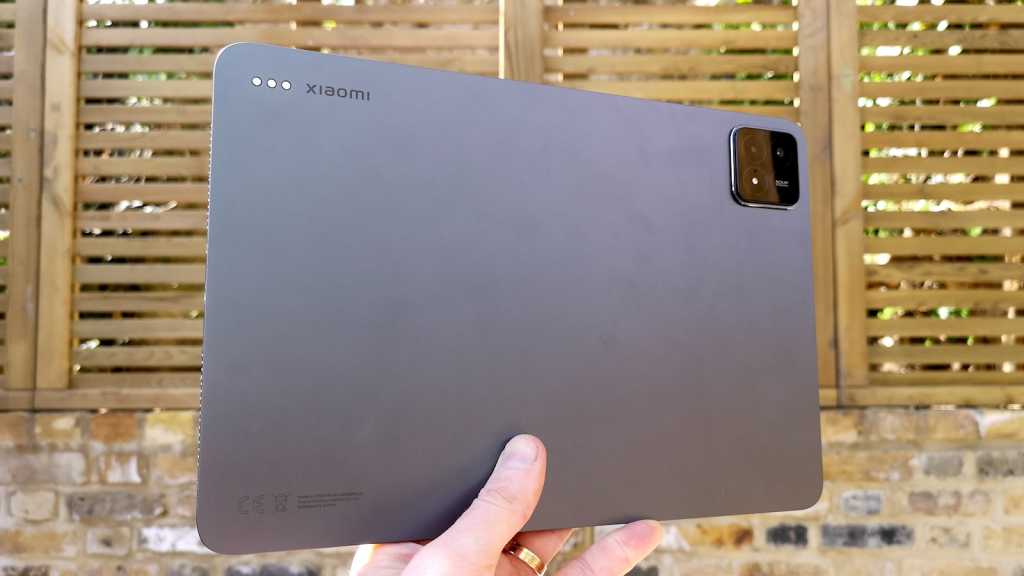Expert's Rating
Pros
- Scintillating and smooth display
- Good battery life
- 120W fast charging
- Focus Pen stylus is great fun
Cons
- Limited software support
- Stylus not included
- Officially only works with Xiaomi stylus
- No 5G option
Our Verdict
The Xiaomi Pad 6S Pro is a powerful, capable Android tablet with a super-smooth display, great entertainment features, and compares well on price with the Samsung Galaxy Tab S9 Ultra and Apple iPad Pro (2022). That said, if you don’t need a tablet for artistic and work reasons, a mid-range Android tablet like the Xiaomi Pad 6 might be a better value choice.
Xiaomi’s latest high-end Android tablet is the Pad 6S Pro 12.4, and it’s something of a head turner – sleek all-metal body and a 12.4-inch 3K display on the outside, powerful Qualcomm Snapdragon 8 Gen 2 processor with up to 12GB memory and 512GB of storage on the inside.
As well as offering buyers an alternative to the Samsung Galaxy Tab S9 Ultra – another powerful Android tablet – and the Apple iPad Pro (2022), Xiaomi has made a tablet that appears to be able to do anything.
Powerful speakers and a detailed display promise a great multimedia experience. There’s also a Xiaomi Focus Pen stylus, which as well as letting you doodle and take notes on the Pad 6S Pro, comes with an interesting cropping feature, and a rubberised cover with a kickstand.
There’s also the Touchpad Keyboard dock in the pipeline, which should let you crack on with some work when you’re done with streaming and sketching – this peripheral was not provided with the review sample, sadly, and at the time of writing, neither was a release date.
With prices starting at £599, the Xiaomi Pad 6S Pro is also competitively priced, and could do for high-end Android tablets what the Xiaomi Pad 6 did for mid-range tablets.
Take a look at our current picks for the best tablets money can buy.
Design & Build
- Wafer-thin all-metal jacket
- Camera module juts out from the body
- You’ll probably want a case
It’s hard to believe that the thin edges of the device house no fewer than six external speakers
The Pad 6S Pro’s body is made from a metal alloy that’s available in just one colour, a dark silver which Xiaomi calls ‘graphite grey’. Currently, the official Xiaomi Pro Cover folding case is also only available in grey. Hopefully more colour options will be made available sooner.
The metal jacket and 7mm bezel give the Pad 6S Pro a smart, tidy look. It’s hard to believe that the thin edges of the device house no fewer than six external speakers – two speaker grilles sit on either edge.
On the left-hand edge of the Pad 6S Pro (when holding it in portrait mode) you’ll find the power button. The volume rocker sits around the corner, on the top edge of the device, which makes for easy screenshot taking.

Thomas Newton / Foundry
The top edge also features a magnetic strip, for the Focus Pen stylus to be connected to for charging and storage. Over on the right hand side between the two speaker grilles is a Type-C USB port. There are no ports, connections, or grilles on the bottom edge.
The front-facing camera sensor is tiny, barely noticeable in the bezel. Over on the rear is a camera module which looks like it’s been transplanted from the Xiaomi 14 smartphone. It rises about 2mm up from the rest of the tablet’s body, which means that the Pad 6S Pro won’t rest flush with a desktop. If I were a cynic, I’d say that the intent here is to force you to buy a protective cover with your tablet.
The Pro Cover, with its rubbery coating, makes the Pad 6S Pro easier to grip and hold, plus, the clasp helps the stylus in place when it’s charging. While the tablet is fairly weighty, you can (just about) hold it in one hand and swipe and sketch in the other.
Note that it doesn’t come with an IP rating for dust and water protection like the IP68 Tab S9 range.
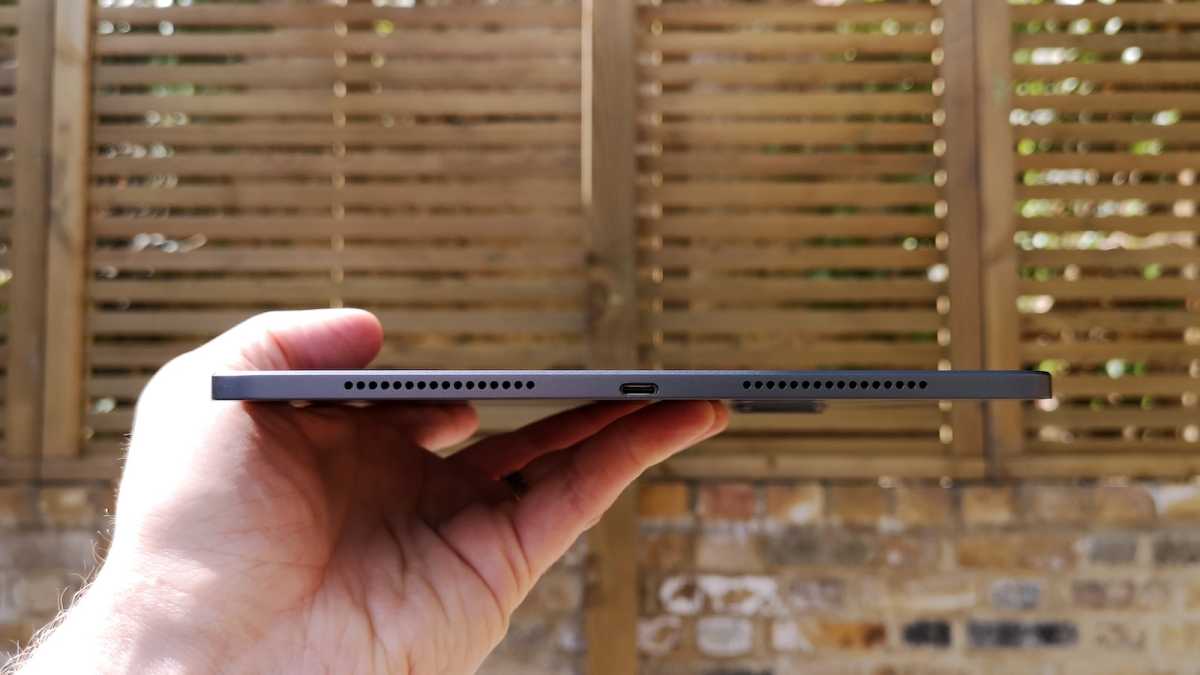
Thomas Newton / Foundry
Screen & Speakers
- 12.4-inch LCD panel
- Maximum refresh rate of 144Hz
- Six external speakers
The Pad 6S Pro’s 12.4in display is an LCD type, meaning that it won’t offer the gorgeous levels of contrast that you get from an OLED display – like the one on the the Samsung Tab S9 Ultra – but with quoted peak brightness of 900 nits, contrast here is still good.
The high resolution and 144Hz refresh rate means that games and video content looks nicely detailed as well. The 3:2 aspect ratio means that video content is letterboxed, but the extra height you get compared with 16:10 displays makes for roomier web browsing and office tasks.
The photos I’ve taken might suggest otherwise, but the display was bright enough to punch through the midday sun, even if the reflective coating does pick up glare pretty badly. With the High Brightness Mode engaged, I recorded peak brightness of 921 nits, slightly higher than the listed maximum. The display is more than bright enough for indoor use.
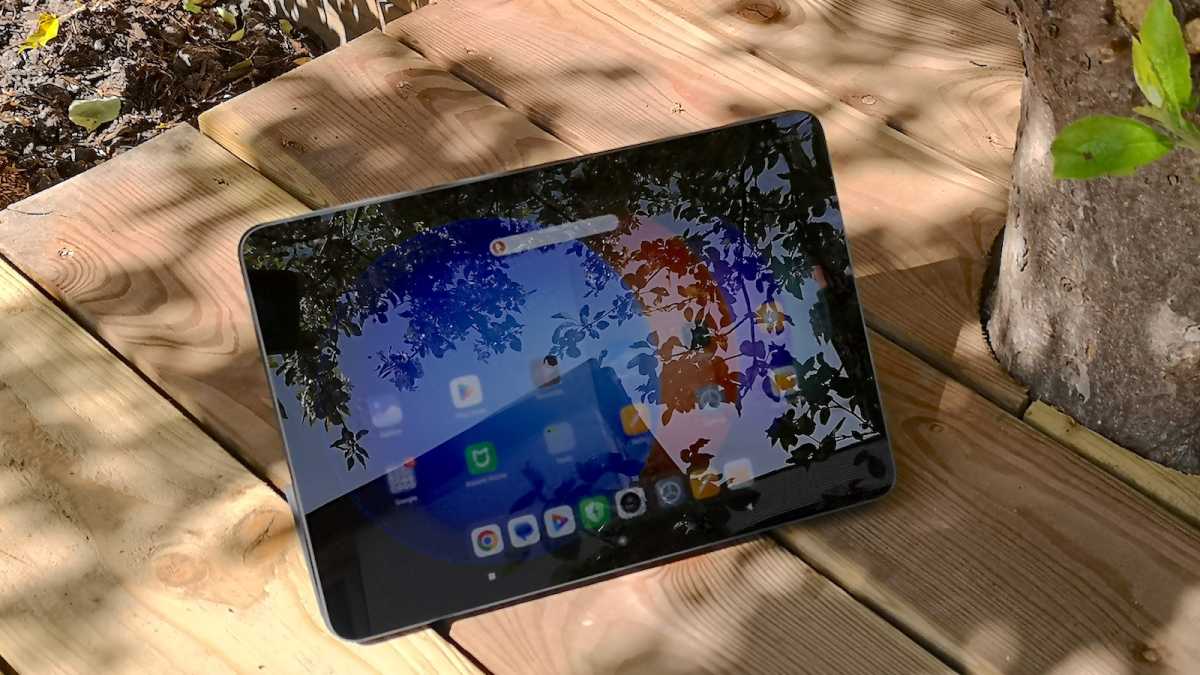
Thomas Newton / Foundry
Audio from videos and music played through the stereo speakers sounds fantastic, all things considered. Dialogue always sounded clear as a bell above background noise, even in action sequences, such as the battle scene of Episode 9 of Shogun.
Tracks with stereo and 5.1 mixes sounded a lot more spacious than they would on most tablets, and while the physical limitations of a device of this size mean that bass response is always going to be limited, I was impressed with how weighty songs sounded.
It’s no substitute for a standalone speaker or soundbar, naturally, but as tablet speakers go, they are very good indeed.
Focus Pen stylus
- 240Hz touch sampling rate
- 8192 levels of pressure sensitivity
- Great for sketching and writing
- Highlighter tool and palm detection needs work
A key selling point of the Xiaomi Pad 6S Pro is the Focus Pen, an active stylus which pairs with the Pad 6S Pro via Bluetooth.
It uses proprietary Xiaomi technology, and according to spokespeople isn’t based on AES technology. In other words, if you try to use another stylus with this, chances are if it does work at all, its functionality will be limited.
As well as functioning as a stylus as you’d expect, the Focus Pen has some interesting tricks up its sleeve

Thomas Newton / Foundry
As well as functioning as a stylus as you’d expect, the Focus Pen has some interesting tricks up its sleeve. There are three controls on the side of the Focus Pen, which let you action different things.
The Writing button (the one closest to the tip) quick-launches the Mi Canvas note-taking and sketching app. The Screenshot button (the middle button) launches a cropping tool, which which you can grab and save specific portions of what’s on your display, or take an entire screenshot, instead of having to reach for the power key and volume rocker.
Finally, there’s the standalone Spotlight button, which can do a number of things. Pressing and holding this button sees a red dot cursor appear on the screen which you can the move around with the stylus, effectively using the Focus Pen like a virtual laser pointer. It’s easy to use, fun, and effective sat close up and stood far away.
While I was able to use this comfortably when stood two meters away, at such a distance, it’s also tricky to see what’s on the display, so perhaps not best employed in large meetings.
Pressing the Spotlight button once brings up a highlighter tool which does a similar thing, although in practice, this is harder to use, thanks to the cursor suddenly veering off in one direction, or the highlighter not always highlighting, even though you’ve got the button pressed down. Trying to make helpful annotations to images felt like performing keyhole surgery with a Nintendo Wii controller.
Another thing you can do with the Spotlight button is use it as a remote camera shutter.
You might be thinking, ‘Yes, this is all very nice, but how does it fare as a stylus?’ Pretty good, as it happens.
The Focus Pen boasts 8192 levels of pressure sensitivity (double that of the Apple Pencil 2nd gen), a 240Hz touch sampling rate (the number of times the Pad 6S Pro’s display can sense the stylus per second), and 3ms of latency (the delay between you writing something and it appearing on the display).
In simple terms, it’s a very sensitive stylus that’ll let you quickly scrawl away with very little activation force.
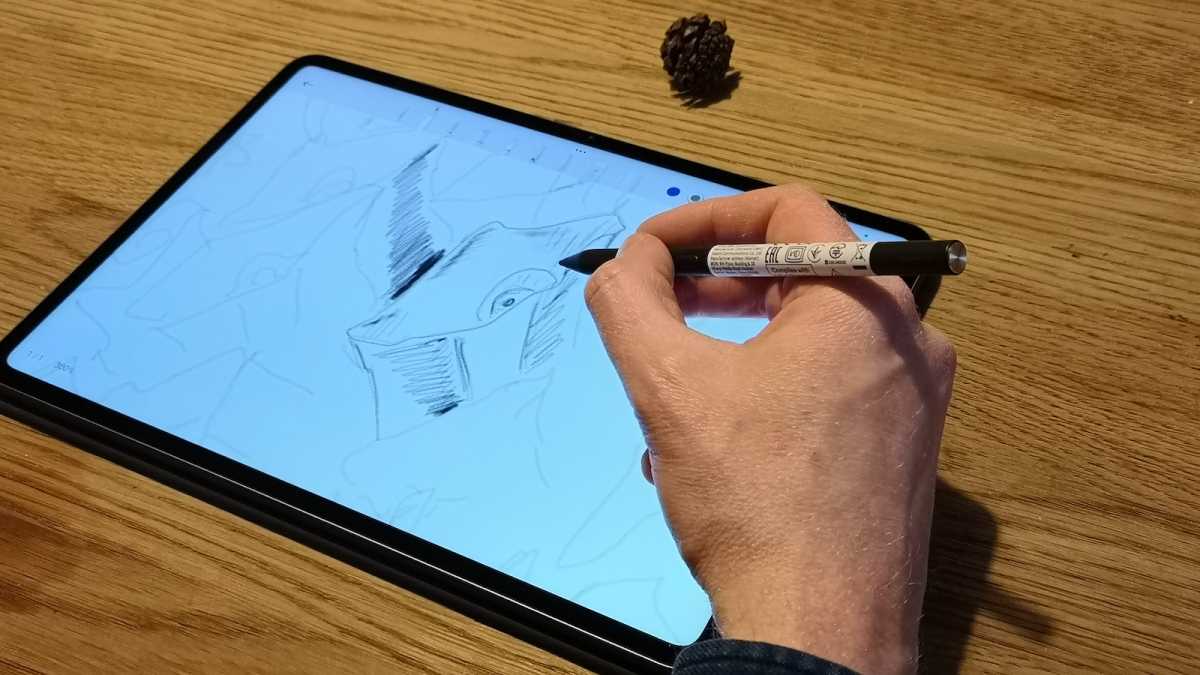
Thomas Newton / Foundry
The Mi Canvas app demonstrates this well – I had a lot of fun producing sketches of pine cones and marvelled at the very subtle changes you can make to drawings. For example, the pencil tool will yield stronger, darker marks the harder you press, as you might expect. With the pencil opacity set to 60%, this effect became uncannily lifelike, as with tiny flicks of the stylus, I could easily add slight details, or heavy shading simply by pressing a mite harder.
This is great not just because of the pleasing effect of the technology, but because it saved me from having to stop drawing, dive into the settings, increase opacity, and jump back. I could have easily missed the deadline for this review as a result of how much fun sketching is.
The ink pen tool was a little slower to respond, with some noticeable delay between pen strokes and the ‘ink’ appearing on the screen. Other than that specific tool in Mi Canvas, there was no discernible delay.

Thomas Newton / Foundry
Mi Canvas also as an intriguing AI Pen tool, but this option is currently only available to beta testers, so I can’t say if it’s an improvement on what we saw at this year’s Mobile World Congress. It can turn a simple, rubbish even, sketch into usable artwork.
The tablet’s palm rejection measures usually worked – the Pad 6S Pro could usually tell whenever I was resting my hand on the display, and wouldn’t pick that up when I was sketching, but, I found that whenever jotting down things in the Notes app in landscape mode, my palm would, more often than not, accidentally launch the keyboard, which was irritating.
Thankfully, I never encountered this when holding the tablet portrait-wise, which is probably how most people will be holding it while taking notes, so arguably, not as big an issue as it might appear but it’s still annoying.
This aside, the handwriting recognition aspect of the Notes app is very good. I really had to try hard, by writing badly on purpose, to fool the software into converting my handwriting into the wrong word, but the majority of the time, the Pad 6S Pro had me beat.
Touchpad Keyboard
- Good typing experience marred by a cramped layout
- Responsive 4-inch trackpad
- Backlit keycaps
The Touchpad Keyboard is a must-buy if you’re after an Android tablet for work and study purposes. On the whole, it offers a reasonably good typing experience, although it’s not without some minor annoyances.
The typing action is pleasant and springy, and the keycaps have a pleasant rubbery feel to them. As you might expect from a small keyboard peripheral that’s designed to be folded up, the keycaps themselves are not very big – consequently, they’re quite thin-feeling, and inevitably, I wonder about their longevity.

rhdr
Thomas Newton / Foundry
In terms of layout, the Touchpad Keyboard is typical of small 13-inch laptops, although the absence of any navigation keys (home, end, page up/down), is frustrating, and the arrow keys are small and too closely bunched up. Likewise, the backspace key is too small and awkwardly positioned for my liking – too close to the ‘+’ key and the Delete key, which can make for some mishaps, although I concede that you would likely learn to live with the cramped layout after a while.
There is a backlight, meaning you’ll be able to work more easily in dark environments, although oddly, the strength of the light can only be adjusted in the Settings – no function keys on the Touchpad let you adjust this, which is a curious oversight.
I’d also like to see – on this and all Android keyboards – physical keys for the Back, Home, and Overview controls, aka the three icons at the bottom of the display, if only to make it easier to switch between windows and processes when working. Having to stop tying, tap something on the screen and then return to the keyboard is an unnecessary speed bump.

rhdr
Thomas Newton / Foundry
Trackpad sensitivity can be increased from the Settings too, although you probably won’t need to, it’s good enough out of the box. While it’s small at 4-inch corner-to-corner, you can easily swipe through menus and move between paragraphs with one thumb.
The Touchpad Keyboard is now on sale. You can buy it directly from Xiaomi for £169.
Specs & Performance
- Excellent overall performance
- Not quite as powerful as the Samsung Galaxy Tab S9 Ultra
- But Xiaomi Pad 6S Pro’s battery lasts longer
The Xiaomi Pad 6S Pro’s performance is very good indeed. As well as the aforementioned Mi Canvas app running very smoothly, high-end game Asphalt 9 ran like greased lightning with added grease.
General everyday operations like web browsing and even just swishing through menus feels fantastic as well, a sensation helped by that 144MHz display.

Thomas Newton / Foundry
There are two versions of the Xiaomi Pad 6S Pro available, one with 8GB of RAM and 256GB of storage, one with 12/512GB, neither of which can be expanded with microSD cards. The model offered for testing is the entry level one.
Both are powered by the octa-core Qualcomm Snapdragon 8 Gen 2 processor, which boosts up to 3.19GHz – slower than the overclocked Samsung variant, which boosts up to 3.36GHz.
It’s perhaps not a shock then to see that the Samsung Galaxy Tab S9 Ultra leaps ahead of the Xiaomi Pad 6S Pro in almost every benchmark, especially the Geekbench CPU stress test. It’s a little behind the Apple iPad Pro 12.9 as well – a tablet from 2021.
But, to paraphrase Blade Runner, the tablet that burns brighter eats through battery power more quickly – the Xiaomi Pad 6S Pro may not be as powerful as these, but it’ll outlast them in a long-distance run (more on battery life later).
Xiaomi Pad 6S Pro 12.4 benchmarks
Connectivity-wise you get Wi-Fi 7 here, promising speeds far above 1Gbps, provided you’re connected to an up-to-date router, and Bluetooth 5.3. There’s no 5G support either.
Cameras
- 50Mp main camera with 2Mp depth lens and LED flash
- 32Mp front camera
Cameras on tablets are rarely much to write home about, and the Xiaomi Pad 6S Pro is no exception.
Photos are comparable with what you’d see from a mid-range phone so stills tend to look fine in daylight, or areas with plenty of artificial light.
more often than not, your snaps tend to look very crisp and detailed
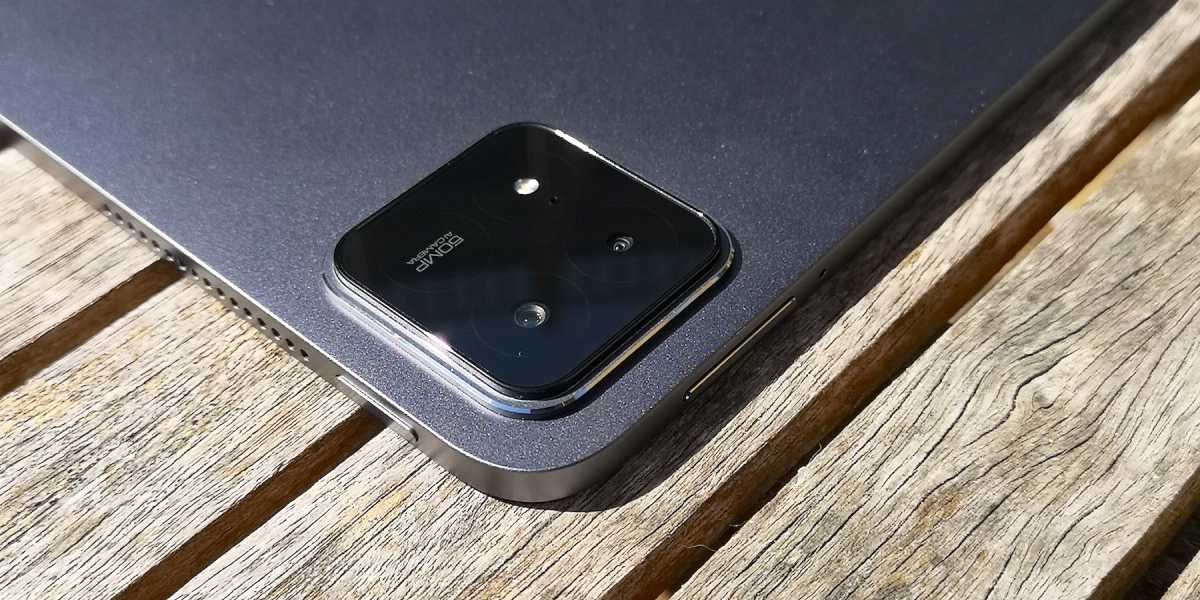
oznor
Thomas Newton / Foundry
The main 50Mp sensor is quick to focus on subjects and takes photos quickly, so more often than not, your snaps tend to look very crisp and detailed. This generally holds up when zoomed in at x2 magnification, but pushed beyond that and things rapidly deteriorate.
Colours are a bit washed out and less vibrant than they are in reality, but overall, results are good. In dark areas, or at night time, it’s a different story.
The best thing about the main camera for me is the document scanner tool, which does a good job of quickly zeroing in on what you want.
The front-facing 32Mp camera is fine for video calls. The angle that the Pad 6S Pro sits at with the Pro Cover kickstand out means that people on the other end get a good look at your face instead of looking up your nostrils or directly at your chin.
Stills are not so good, as the results are often quite grainy and noisy.
Battery Life & Charging
- 10,000mAh battery is enough power for a working day
- Lasted over 9 hours in benchmark test
- Charges back up from flat in just over 40 minutes
It’s great to see that percentage counter go up so quickly.
The battery life of tablets typically isn’t great, especially if they have bright, detailed displays, but the Xiaomi Pad 6S Pro fared a little better than most.
Running the PCMark Work 3.0 benchmarking tool with brightness locked at 200 nits saw the Xiaomi Pad 6S Pro lasting nine hours and 10 minutes, slightly ahead of similarly ‘specced tablets. The battery will sit at around 80-85 after an hour of streaming music on YouTube or watching TV.
Best of all though is how quickly you can fill up the tank with the whopping 120W mains adapter. From empty, after 15 minutes, I was at 48%, and after half an hour, 81%, finally hitting 100% after 43 minutes.
It’s great to see that percentage counter go up so quickly.

Thomas Newton / Foundry
Software & Features
- Xiaomi HyperOS on top of Android 14
- Some (but not all) bloatware can be removed
- Two years of OS updates
- Three years of security updates
The Pad 6S Pro’s user interface is reasonably easy to get to grips with, and will be instantly familiar to anyone who has used an Android tablet before.
Specifically, it comes with Xiaomi’s new HyperOS custom user interface running on top of Android 14. It doesn’t hugely differ from the stock Android experience and is a fairly inoffensive custom UI.
Most of the things you’ll want to start playing with are put right in front of you after you’ve finished setting the thing up – although, bizarrely, Xiaomi decided to hide the excellent Mi Canvas app away on the menu screen immediately to your right.
Dragging down from the top right corner opens the quick settings panel where you can toggle Wi-Fi, Bluetooth, brightness and the like.

Thomas Newton / Foundry
While on the surface, HyperOS doesn’t look much different to Xiaomi’s old MIUI interface, it’s less resource-intensive.
HyperOS comes with a handful of Xiaomi apps and services pre-installed, like Xiaomi Home, a hub through which you can manage and control Xiaomi smart home devices – and is therefore only really useful if you actually have any Xiaomi smart home devices. If you don’t, at least you can uninstall it – which is more than you can say for the Mi Browser, which you can’t uninstall.
As I didn’t have a Xiaomi phone to hand while testing out the Pad 6S Pro, I can’t say how well the new Home Screen+ feature works – this lets you cast your phone’s screen to your tablet and interact with it remotely.
In terms of support, Xiaomi confirmed that the Pad 6S Pro will get two years of OS updates and three years of security cover. It’s a basic level of support and we would hope for more considering Xiaomi offers four years OS and five years of security for its flagship phones.
When you could be spending a lot of money between the tablet and its optional accessories, it only lasting three years on the software side isn’t great value for money. The likes of Samsung and Google offer longer support.
Price & Availability
The Xiaomi Pad 6S Pro is on sale now, although note that at the time of writing, availability is limited.
In the UK, you can buy directly from Xiaomi, where the 8/256GB and 12/512GB models are available for £599 and £699 respectively.
You can also pick up the Focus Pen stylus from Xiaomi for £79, and the Pro Cover for £29.
The Touchpad Keyboard is not yet on sale, and no launch date has been announced, but Xiaomi has confirmed to me that it will be priced at £169.
Note that the Xiaomi Pad 6S Pro 12.4 will not be going on sale in the United States, Canada, or Australia.

Thomas Newton / Foundry
Should you buy the Xiaomi Pad 6S Pro 12.4?
If you’re in the market for a high-end tablet and you’re interested in branching out into digital art, or just generally like the idea of getting some sketching done in between work and Netflix binges, then the Xiaomi Pad 6S Pro ought to be on your shopping list.
It might not be as powerful as the Samsung Galaxy Tab S9 Ultra – still the most capable Android tablet out there – but it’s smaller and therefore easier to carry around, the battery lasts longer, and it’s considerably less expensive as well.
If sketching or using a stylus to take notes is of less importance to you, then the mid-range Xiaomi Pad 6 might be a better option, or the Lenovo Tab P12 Pro – it might be a model from 2021, but it’s still a good value-for-money buy.
What the Pad 6S Pro doesn’t have on its side compared to rivals is longevity thanks to short software support.
Specs
- Display: 12.4in 144MHz 3:2 LCD display
- Resolution: 3K (3,048×2,032), 3:2 aspect ratio
- Processor: Qualcomm Snapdragon 8 Gen 2, Octa-core up to 3.19GHz
- Storage: 256/512GB
- RAM: 8/12GB
- Camera: 50Mp+2Mp front, 32Mp rear
- Connectivity: Wi-Fi 7, Bluetooth 5.3
- Sound: Six Dolby Atmos-branded stereo speakers, microphone
- Battery Life: Up to 9 hours
- Charging: USB-C (USB 2.0)
- Weight: 278.7 x 191.6 x 6.26mm
- Dimensions: 590g

